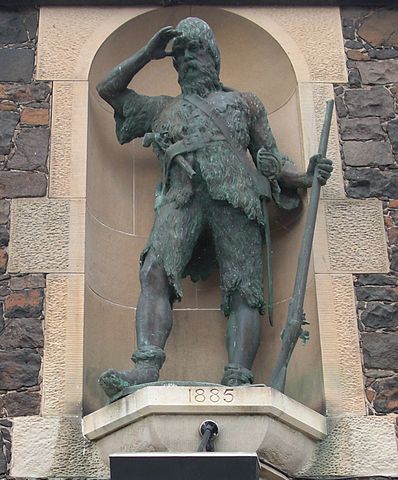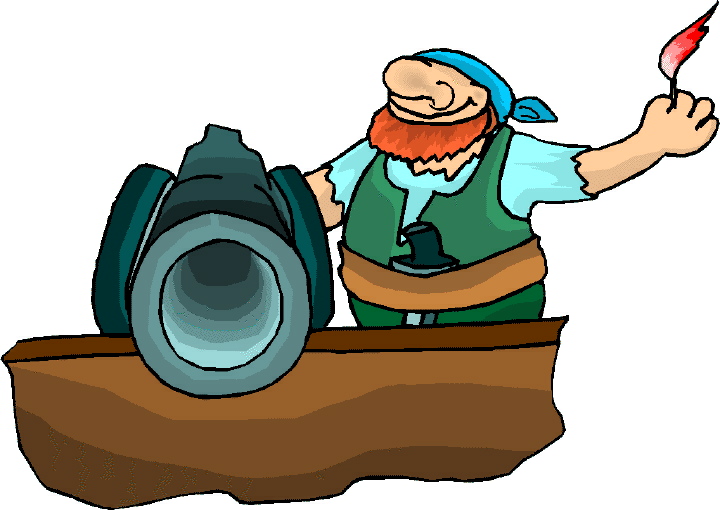 Pirates and Privateers Pirates and Privateers
The History of Maritime
Piracy
Cindy Vallar, Editor
& Reviewer
P.O. Box 425,
Keller, TX 76244-0425
    
A Most
Unwelcome Death
by Cindy Vallar
To put ashore and abandon on a desolate island
or coast
To isolate
without aid or resources
Pirates of yore sailed under articles
that governed them while at sea. If violated, the quartermaster
enforced the prescribed punishment. The infractions
that merited the severest consequence were stealing
from the crew or abandoning one’s post in battle.
The punishment? Marooning – the most dreaded of all
punishments, for it promised a slow, cruel death
without hope of reprieve.
Both Bartholomew
Roberts’s and John
Phillips’s articles included this punishment
and listed precisely what items the disgraced pirate
would be given if marooned on a deserted island,
preferably a sand bar without fresh water, food, or
shelter. He took with him the clothes he wore, a
bottle of water (usually one day’s worth), a pistol,
powder, and shot. His mates returned to their ship
and sailed away, leaving him to die.
The island was a prison from which there was little
chance of escape. The hot sun burned and blistered
his skin. Without food and water he starved and
became dehydrated. At high tide, the water might
flood the island or leave him standing in water up
to his neck. Woe to him if sharks infested the
surrounding water. If he preferred a quick death, he
could kill himself with the pistol. To do that,
however, damned his soul forever.
Some men survived marooning, but those were rare
cases. If pirates rescued a marooned man, they might
allow him to join their crew. If merchantmen or
warships found him, they assumed him a pirate and
delivered him to the nearest port for trial.
This happened to Charles
Vane, an unpopular pirate captain.
Although a castaway rather than a marooned pirate,
Vane was stranded on an unpopulated island for
several months after a shipwreck. Identified as a
pirate in 1720, he was taken to Port Royal,
found guilty, and hanged.
 Alexander
Selkirk requested to be put ashore because of
frequent disagreements with his captain. When he
made the request, he expected fellow pirates would
join him. They didn’t and his fate was sealed. His
home for the next 4½ years was Más á Tierra – one of
the Juan Fernandez Islands situated 400 miles off
the Chilean coast – where food and water were
plentiful. Woodes
Rogers rescued Selkirk in 1709. Two
years later they returned to London where Richard
Steele, an essayist, published Selkirk’s story.
Daniel Defoe immortalized Selkirk when he penned his
most famous work, Robinson
Crusoe, still a classic more than 200
years after its publication in 1719. Alexander
Selkirk requested to be put ashore because of
frequent disagreements with his captain. When he
made the request, he expected fellow pirates would
join him. They didn’t and his fate was sealed. His
home for the next 4½ years was Más á Tierra – one of
the Juan Fernandez Islands situated 400 miles off
the Chilean coast – where food and water were
plentiful. Woodes
Rogers rescued Selkirk in 1709. Two
years later they returned to London where Richard
Steele, an essayist, published Selkirk’s story.
Daniel Defoe immortalized Selkirk when he penned his
most famous work, Robinson
Crusoe, still a classic more than 200
years after its publication in 1719.
No pirate captain was assured of his command. Voted
in by his crew, they could also vote him out. That
happened to an English pirate named Edward
England. While off the coast of Africa, the
pirates accused him of coddling the prisoners and
marooned him and two others on the island of
Mauritius. According to some, they built a boat and
escaped to Madagascar
where England died soon afterwards.
Fellow mates weren’t the only ones whom pirates
marooned. Their victims also suffered a similar
fate. Captain
Barnabas Lincoln and eleven others were
marooned on an island after pirates captured his
ship off Cuba in 1821. The pirates provided them
with fresh water, flour, ham, salted fish, a cooking
pot, and blanket before stranding them on a small
island three feet above sea level. Three days after
one man died, they built a leaky boat with room for
only six of the remaining ten men. On the eighteenth
day on the island, Lincoln and his comrades sighted
a boat, and two of them rowed for five hours to
reach it only to discover it was the boat they had
built and its crew of six were nowhere to be seen. A
rescue ship arrived the next day and when they
finally reached port, they found the other six men
who had happened upon a pirate ship, stolen one of
her boats, and let the leaky boat drift away.
When mutineers seized Captain William Greenaway’s
ship, they marooned him for refusing to turn pirate.
At first, the pirates landed him and seven others on
an uninhabited island in the Bahamas without food,
water, or clothing. The pirates returned later and
transferred them to a captured sloop anchored a mile
from shore. Again left without provisions, the men
faced death.
The discovery of a hatchet blade saved them.
Greenway swam ashore, built a raft, and returned
with food. They mended the fouled sails and slashed
rigging, but the pirates sank the sloop in deep
water after returning the men to the island. Eight
days later, the pirates came back again and forced
Greenaway and two others to join them. The pirates
returned twice more: first to deposit supplies and
second, to burn the shelter built by the remaining
marooned crew. Not long after Spaniards captured the
pirates. On hearing Greenway’s story, they affected
a rescue of those who remained loyal to him.
To be alone on a sandy island surrounded by salt
water and without provisions was an excruciating and
terrifying way to die. When next you think how
romantic it might be to live on a deserted island,
gaze upon Howard Pyle’s "Marooned" and reflect on
the death that awaits that pirate.
Review
Copyright ©2001 Cindy Vallar

Click to contact me
Background image compliments
of Anke's Graphics |

